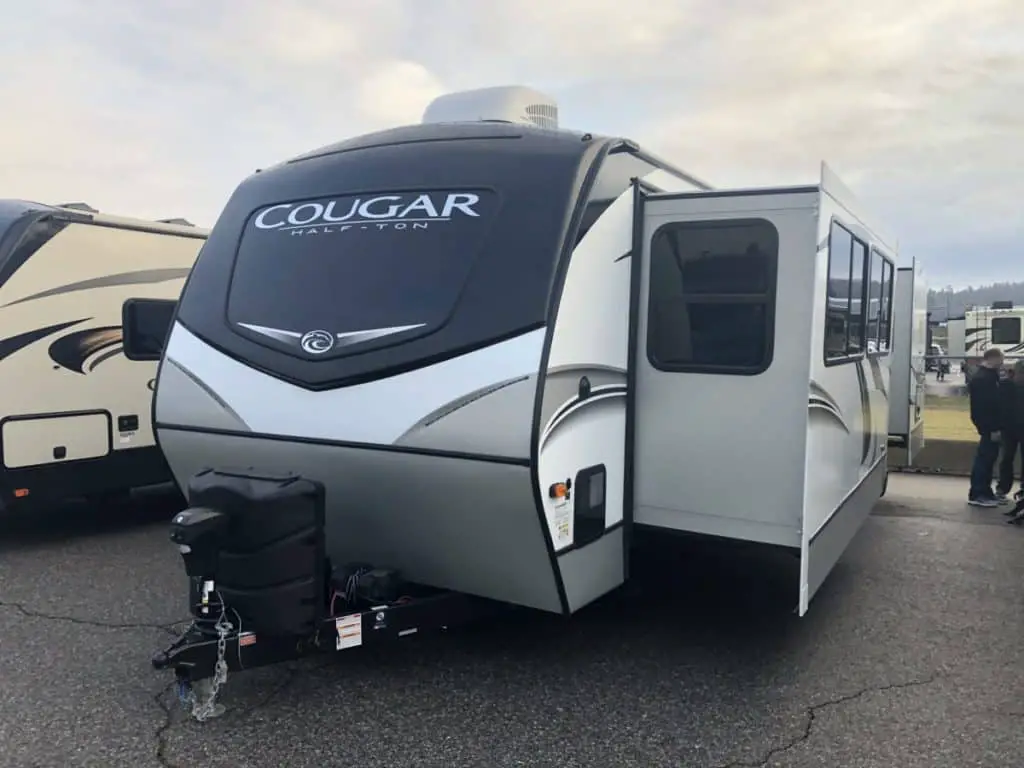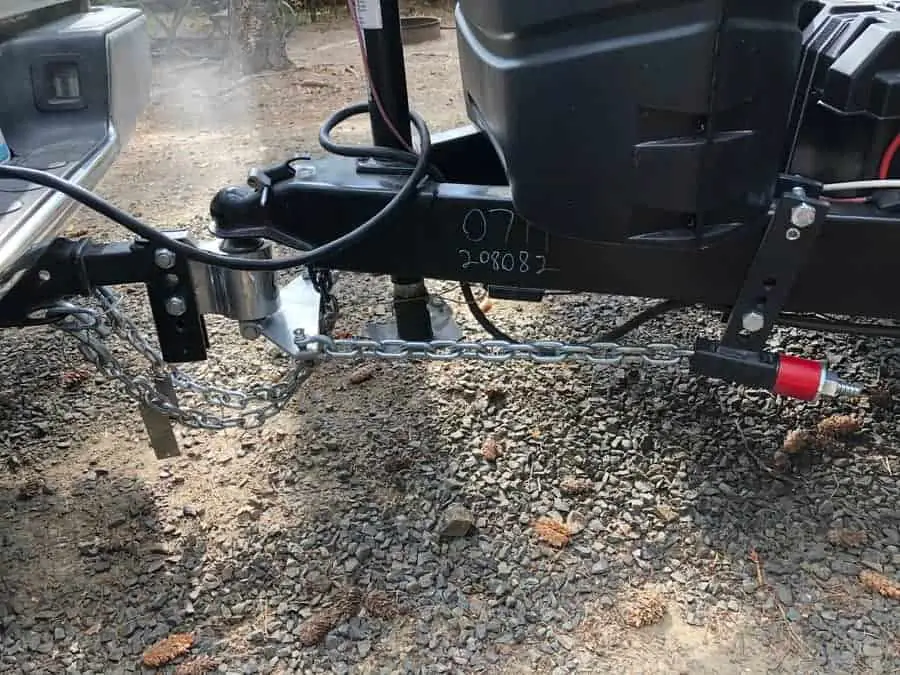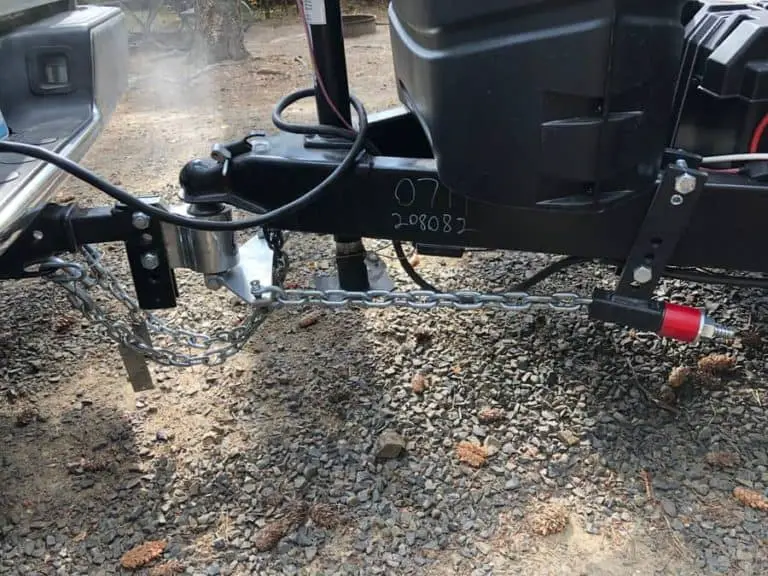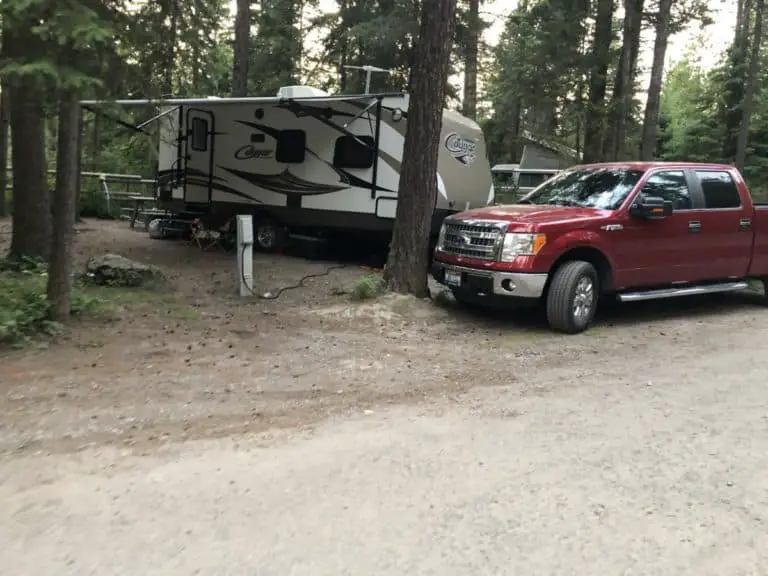Why a Travel Trailer Weight Distribution Hitch is Essential: Choosing the Right One for Your Needs
Are you a regular traveler who loves touring the world using a travel trailer? If yes, you may recall one nerve-wracking moment when the trailer swayed off the road, and you nearly lost control of the vehicle. Although swinging is a common phenomenon when pulling a heavy load, you can prevent it and avert accidents using a weight distribution hitch.
Weight distribution hitches are important when towing a travel trailer as they reduce sway, improve steering by shifting weight from the rear axle to the front, reduce wear on your vehicle, improve your towing capacity, increase your breaking ability, and will correct the sag in your rear suspension.
Read on to understand how a trailer weight distribution system works and why you need the device when towing heavy loads.
Why you need a Travel Trailer Weight Distribution Hitch:

Importance of Weight Distribution
A weight distribution hitch is essential for your travel trailer because it ensures proper weight distribution among the axle of your tow vehicle and the axle of your trailer. This even distribution of weight helps to maintain balance and stability while you’re on the road.
The easiest way to appreciate the function of the weight distribution hitch is to understand what happens when pulling a heavy trailer.
First, you’ll have a towing vehicle and trailer to haul the heavy loads. However, the towing car should have a robust suspension system to pull the heavy load.
If the suspension unit is weak, the towing vehicle will bend upward, with the rear end sagging toward the trailer at the back. A weight distribution hitch is what you need to correct the situation.
The primary purposes of the distribution hitch include:
Weight Distribution
The hitch forms a vital bridge between the trailer and the towing vehicle. Once you link the two units, the hitch distributes the tongue weight uniformly to the towing axle and front steering axle and the trailer, resulting in a single unit parallel to the road.
The hitch works like a standard ball mount except that it uses a set of spring bars or chains to accomplish weight distribution.
- First, the spring bars/chains absorb excessive stress and tension, producing a lifting effect on the rear of the vehicle by placing trailer tongue weight on the front axle of the towing vehicle.
- Second, the tension created cancels any downward pressure on the vehicle, resulting in a leveled trailer and towing vehicle.
Safety and Stability
When the weight of your travel trailer is properly distributed, it increases the overall safety and stability of your towing setup. This reduces the chances of accidents due to the trailer swaying or losing control while navigating through various road conditions.
Improved Towing Capacity
By using a weight distribution hitch, your towing capacity is significantly improved and for most vehicle manufacturers, you now unlock the maximum towing numbers your vehicle advertises.
With the distributed weight, your tow vehicle can accommodate heavier loads which would otherwise strain and damage the towing system.
Reduced Trailer Sway
Sway control refers to the trailer’s ability to withstand external forces that may push it back and forth when driving. Swaying may occur due to strong winds, uneven weight distribution, speedy driving, road imperfections, sudden application of brakes, or bow waves from other trucks on the road.
Luckily, the spring bars on the weight distribution hitches prevent swaying by keeping the towing vehicle and the trailer in line. As a result, you’ll reduce the chances of toppling, especially when driving at high speeds.
To learn more about how weight distribution hitches assist in sway control, check out this article.
Increased Braking
Uneven weight distribution can lead to poor braking performance and increased stopping distances. By evenly distributing the trailer’s weight across the tow vehicle’s axles, a weight distribution hitch improves braking, helping you stop more efficiently in various road conditions.
Reduced Wear and Tear
Using a weight distribution hitch not only enhances your towing safety and performance but also reduces stress on your tow vehicle and trailer. It minimizes wear and tear on both the tow vehicle’s suspension and the trailer’s frame, prolonging their lifespan and maintaining optimal performance.
In summary, a weight distribution hitch is essential for safely and comfortably towing a heavy trailer. It offers safety benefits, improved vehicle control, leveling of the tow vehicle and trailer, increased braking, and reduced wear and tear. Investing in a quality weight distribution hitch will enhance your towing experience and help protect your tow vehicle and trailer.
Fuel Economy
Proper weight distribution also has a positive impact on your fuel economy. The even distribution of weight allows your tow vehicle to maintain consistent speeds and reduces the need for constant acceleration, which in turn results in better fuel consumption.
Reduced Structural Damage
Without a weight distribution hitch, the excessive weight on your RV hitch may result in damage to both your tow vehicle and your trailer. By evenly distributing the weight, structural damage is minimized, and you protect your investment in both your vehicle and your trailer.
Components of a Travel Trailer Weight Distribution Hitch
When setting up your travel trailer, it’s essential to have a weight distribution hitch to ensure safe and comfortable towing. In this section, we’ll discuss the primary components of a weight distribution hitch and their functions.
Head Assembly
The head assembly is the main component that connects your travel trailer to the tow vehicle. It’s crucial to choose a head assembly that fits your RV’s hitch weight and is compatible with the manufacturer’s specifications. The hitch head is designed to hold the spring bars and sway control devices securely. Selecting the right head assembly ensures proper weight distribution and helps prevent sway.
Spring Bars

Spring bars are essential components of a weight distribution hitch. Their primary function is to redistribute the hitch weight from the back of the tow vehicle to the front wheels and the axles of the travel trailer. Spring bars come in two main types: round bar and trunnion bar. While both types serve the same purpose, trunnion bars are usually more robust and better suited for heavier RVs. Make sure to choose spring bars that match your RV’s weight rating.
There are two main types of spring bars and one type with chains:
- Round bars: These are the most common type and are attached to the head assembly using chains and clips. They offer good weight distribution at a lower cost but may have less ground clearance.
- Trunnion bars: These bars slide directly into the head assembly and offer better ground clearance and a more rigid connection, although usually at a higher price.
- Chains: Chains can also be used to redistribute the weight on weight distribution hitches. The Andersen is the only hitch that uses chains. The benefits are more customizable weight distribution, lighter unit overall, and quieter (no annoying noises when turning). We have this Andersen hitch and LOVE it.
Shank
The shank is a critical component that connects the head assembly to the tow vehicle’s hitch receiver. Ensuring a proper fit requires selecting a shank with the appropriate size and rise/drop for your tow vehicle. It’s crucial to note that not every shank can fit every hitch head, so always refer to the manufacturer’s guidelines when choosing your shank.
Frame Brackets
Frame brackets are mounted on the travel trailer’s frame and provide a connection point for the spring bars. These brackets vary in design depending on the spring bar type (round or trunnion), but they ensure a secure connection and proper weight distribution. Make sure to follow your manufacturer’s recommendations for installing and adjusting frame brackets on your trailer frame.
Sway Control Devices
While not a mandatory part of a weight distribution hitch, sway control devices are recommended for better towing performance, especially for larger or longer trailers. Sway control devices help to limit side-to-side movement and sway, improving both the tow vehicle and travel trailer’s stability. There are two primary types of sway control devices: friction sway control and dual-cam sway control. Choose the sway control device that suits your towing needs and ensures proper compatibility with your weight distribution hitch.
By carefully selecting and setting up each component of your weight distribution hitch, you’ll ensure a safe and enjoyable towing experience for your travel trailer.
Types of Weight Distribution Hitches
Weight distribution hitches help to control trailer weight and maintain balance between your towing vehicle and the trailer you’re towing. There are three main types of weight distribution hitches: Round Bar Hitches, Trunnion Bar Hitches, and Andersen Hitches Weight Distribution Hitch. In this section, you’ll learn about each of these types and their specific advantages.
Round Bar Hitches

Round bar hitches use round bars that attach to the trailer frame and provide tension and control over the trailer’s weight. These bars redistribute the trailer weight more evenly across the towing vehicle and trailer axles.
- Advantage: Round bar hitches offer a more affordable solution for weight distribution and are suitable for smaller trailers and RVs.
- Limitation: They might not provide the same level of tension as trunnion bar hitches.
Trunnion Bar Hitches

Trunnion bar hitches use trunnion bars rather than round bars and are known to offer greater tension and control over trailer weight. These hitches have a square design and attach to the trailer frame but offer a tighter bracket connection.
- Advantage: Trunnion bar hitches are known for providing greater weight distribution and are better suited for heavier trailers and RVs.
- Limitation: They tend to be more expensive and might require more maintenance than round bar hitches.
Andersen Hitches Weight Distribution Hitch

Andersen Hitches Weight Distribution Hitch is a unique solution that combines the benefits of both round and trunnion bars. It uses a chains-and-bracket system instead of bars, providing increased tension and control while eliminating the need for sway control.
- Advantage: The Andersen Hitches Weight Distribution Hitch is known for its ease of installation and flexibility, as it can be used with a variety of trailer and ball mount sizes. It also offers better ground clearance compared to bar-based systems.
- Limitation: Though effective, this system can be more expensive than the other two options.
Choosing the right type of weight distribution hitch for your towing needs will depend on factors such as trailer weight, towing vehicle, and budget. It’s important to carefully consider the options and their advantages to ensure you’re making the best choice for your situation.
Selecting the Right Weight Distribution Hitch
Determining Towing Capacity and Hitch Weight
To choose the right weight distribution hitch, you first need to determine your tow vehicle’s towing capacity and the Gross Vehicle Weight Rating (GVWR) of your trailer. This information is typically found in your vehicle owner’s manual or on the trailer’s identification label. Take note of these values as they will help you select a hitch with the appropriate weight capacity.
Next, estimate your hitch weight. Hitch weight is the downward force exerted by the trailer’s coupler on the tow vehicle’s hitch. Ideally, hitch weight should be about 10-15% of the trailer’s loaded weight, including cargo. Once you have these values, look for a weight distribution hitch with a capacity that can handle your trailer’s hitch weight and evenly distribute the load across the tow vehicle’s axles.
Compatibility with Tow Vehicle and Trailer
Ensure the weight distribution hitch you choose is compatible with both your tow vehicle and trailer. Check the hitch receiver size on your vehicle and the coupler size on your trailer. Most weight distribution systems come with an adjustable shank, so make sure it fits in your tow vehicle’s receiver.
Additionally, your weight distribution hitch should be able to accommodate the specific type of frame mounted on your travel trailer. Some trailers have round tube frames, while others have square frames. Select a hitch with adjustable spring bars that can attach to your trailer’s frame type.
Evaluating Hitch Features
When comparing hitch options, consider the following features to make the best choice for your needs:
- Weight capacity: Ensure the hitch can handle your trailer’s loaded weight and hitch weight. Exceeding these limits can cause damage to your trailer or tow vehicle.
- Adjustable spring bars: Choose a hitch with spring bars that are adjustable in both length and angle. This allows you to fine-tune the system for optimal weight distribution and sway control.
- Sway control: Some weight distribution hitches include built-in sway control, while others require additional components. Depending on your towing needs, consider investing in a hitch with integrated sway control for better stability on the road.
- Ease of installation and adjustment: Opt for a hitch that is easy to install, whether you’re doing it yourself or having a professional handle the job. This will save you time and effort, making your towing experience more enjoyable.
By considering these factors and selecting a weight distribution hitch that meets your towing capacity and hitch weight requirements, matches your tow vehicle and trailer compatibility, and offers useful features, you will significantly improve your towing experience, ensuring safer and smoother travels.
Installation and Adjustment
Properly Attaching the Hitch
When installing a weight distribution hitch (WDH) on your travel trailer, you’ll first need to attach it to the hitch receiver on your towing vehicle. Make sure the hitch ball is compatible with the trailer’s coupler. Use retaining pins to secure the hitch head to the hitch receiver, ensuring a tight and secure connection.
Next, attach the spring bars to the hitch head. You should align and lock them into place, using a-frame clamps where necessary. It’s essential to double-check that all components are securely fastened to avoid any accidents or structural damage.
Setting the Correct Tension on Spring Bars
Adjusting the tension on spring bars ensures level towing and better vehicle control. Proper tension is crucial for a safe towing experience, as it helps with braking, ground clearance, and fuel economy. To set the correct tension, first, measure the distance between the ground and your vehicle’s front and rear wheel wells. Then, adjust the spring bars by increasing or decreasing the chains’ links on the lift brackets.
When the front and rear wheel well heights are even, or the front is slightly lower than the rear, you’ve properly adjusted the spring bar tension. Keep in mind that achieving perfect tension may take a few tries, so be patient and make minor adjustments as needed.
Levering Tools and Techniques
Levering tools are essential for efficiently utilizing the WDH. A levering tool will help you easily adjust spring bar tension and is necessary for reaching the optimal setting for your towing system. Use the tool to move the chains to the desired links on the lift brackets, making sure to retain the same number of links on both sides.
Remember, safety and vehicle control are vital during the installation and adjustment process. Always consult the manufacturer’s guidelines and other resources for specific products and WDH systems. If you have questions or encounter any issues, don’t hesitate to reach out to a professional for guidance. By properly installing and adjusting your weight distribution hitch, you’ll ensure a safer and more efficient towing experience.
When Should You Use a Weight Distribution Hitch?
The towing vehicle’s user guide has detailed towing specifications and weight distribution instructions. It is, therefore, advisable to read and abide by the user guide for safety instructions when towing a trailer.
Generally, if you own a mid-sized or half-ton truck, you’ll require a towing hitch for a 5,000-pound (2,268 kg) trailer weight or more. On the other hand, a heavy-duty truck may require a weight distribution hitch for weights ranging from 6,000 to 8,500 pounds (2,722-3,855 kg).
A towing hitch may also be necessary for the following circumstances:
- The trailer weighs more than 50% of the towing vehicle.
- The trailer is constantly swaying on the road.
- The rear axle of the towing car is sagging when pulling the trailer.
- You experience difficulty controlling the vehicle when pulling the trailer.
- You wish to tow at the maximum capacity allowed for the trailer hitch.
Important Considerations When Choosing a Weight Distribution Hitch
Weight distribution hitches are available in various types, sizes, and design specifications. As a result, finding the best distribution hitch for your towing needs may take time and effort. Regardless of your choice, ensure it can effectively distribute the trailer’s weight to the axles and the towing vehicle.
The following essential considerations will help you find an appropriate hitch for your vehicle:
The Trailer’s Tongue Weight
Tongue weight refers to the downward force that the trailer exerts on the hitch. The general practice is to measure the tongue weight when the trailer is fully loaded and you’re ready for the journey.
You can measure the tongue weight using a tongue weight scale. An ideal tongue weight should constitute 10-15% of the gross trailer weight. Thus, a gross trailer weight of 5,000 pounds (2,268 kg) requires a tongue weight ranging from 500–750 pounds (227–340 kg).
Type of Brakes
The types of brakes you have on your trailer greatly determine the weight distribution hitch to use. While electric brakes work with all types of hitches, manual brakes may not be effective on some types of towing hitches. You should ensure the hitch is compatible with the brakes installed on the trailer.
Consulting the Experts
When it comes to selecting the right weight distribution hitch for your travel trailer, consulting experts in the field is crucial. These professionals have in-depth knowledge of various hitch systems and their compatibility with different types of trailers.
You can start by reaching out to camping forums or local RV dealerships, where real experts are often willing to share their expertise. Engage in conversations, ask questions, and express your concerns to ensure you’re making the right choice. Don’t hesitate to make phone calls or send emails to experts in the community.
In addition to interpersonal communication, you can also research online resources like the Camping World website or well-known YouTube channels dedicated to travel trailer enthusiasts. These platforms tend to offer valuable insights and reviews from experienced travelers who have dealt with the challenges and benefits of weight distribution hitches firsthand.
Keep in mind that customers who have used a particular hitch system can provide honest and relatable feedback. Reading customer reviews on various online platforms should give you a clearer idea of which hitches work best for specific travel trailers and how they handle different road conditions.
Remember, consulting with experts and evaluating their suggestions will help you make a well-informed decision. This investment of time and effort will pay off when you can confidently purchase and install the ideal weight distribution hitch for your travel trailer, enhancing safety and comfort during your adventures on the road.
Frequently Asked Questions
What are the benefits of using a weight distribution hitch?
Using a weight distribution hitch provides several advantages for towing a travel trailer. It ensures a more stable and level ride while towing, which enhances the safety and comfort of the driver and passengers. It also reduces strain on your tow vehicle’s suspension system, resulting in a smoother ride and improved fuel efficiency.
How does a weight distribution hitch improve towing safety?
A weight distribution hitch improves towing safety by redistributing the hitch’s weight more evenly across both axles of the tow vehicle and trailer. This reduces the risk of dangerous swaying, reduces trailer bounce, and increases tire traction. Additionally, it ensures proper weight distribution between the tow vehicle and trailer, improving braking and steering responsiveness.
Can a weight distribution hitch prevent trailer sway?
Yes, a weight distribution hitch can help prevent trailer sway by evenly distributing the weight and ensuring proper balance between the tow vehicle and trailer. However, it is essential to choose the right model with a built-in sway control feature for maximum sway prevention.
How do I determine the appropriate hitch capacity for my trailer?
To determine the appropriate hitch capacity for your trailer, you must consider your trailer’s Gross Trailer Weight (GTW) and Tongue Weight (TW). Choose a weight distribution hitch with a capacity equal to or greater than your trailer’s GTW and TW. Consult your tow vehicle and trailer owner’s manuals for specific weight ratings and compatibility.
What are the differences between various weight distribution hitch models?
Weight distribution hitch models vary in their design, capacity, and sway control features. Some models use trunnion bars or round bars for weight distribution, while others incorporate a 4-point or 2-point sway control system. It is essential to evaluate the specific needs of your tow vehicle and trailer to choose the most suitable model.
How does a weight distribution hitch affect vehicle handling while towing?
A weight distribution hitch enhances vehicle handling while towing by improving stability, cornering, and braking performance. It ensures that the tow vehicle and trailer are level while towing, which enhances steering control and reduces trailer sway. This, in turn, creates a safer, smoother, and more comfortable towing experience.
Do all travel trailers require a weight distribution hitch?
Not all travel trailers need a weight distribution hitch. Smaller and lighter trailers may not need one, especially if your tow vehicle has a sturdy suspension and needed capacity. However, if your trailer weight is more than 50% of your tow vehicle’s weight or if you experience sway and stability issues while towing, a weight distribution hitch is recommended.
What is the difference between a weight distribution hitch and a sway control hitch?
A weight distribution hitch focuses on evenly distributing the trailer’s weight, improving stability by reducing sway and maintaining proper alignment between the tow vehicle and trailer. A sway control hitch, on the other hand, is specifically designed to minimize side-to-side movement of the trailer due to wind, passing vehicles, or uneven roads. Some weight distribution hitches also incorporate sway control to provide both functions in a single system.
Be the first to be notified about FREE tips, hints, coupon codes, and email-exclusive information. All for FREE!









